[/caption]
Listen to the audio of this podcast at this link.
You can also read the interviews below.
Hi, this is Nancy Atkinson from Universe Today. Right now I’m at Kennedy Space Center, and I’ve had the opportunity to see a couple of launches and cover other events that normally, I’d be back home watching on NASA TV. Since NASA TV is part of my daily diet of space media, I was very interested to see the newsroom, step in the auditorium where all the press conferences are held, and also talk with some of the people who work at NASA TV at Kennedy Space Center, or KSC TV as they call it, to find out about the work that they do, and also what it’s like to provide some of the most unique and exciting coverage anywhere on — and off — the planet. I chatted with producers, directors, technicians and other people who work behind the scenes, plus I also had the good fortune to talk with one of the voices of NASA TV, George Diller.
Here are some of our conversations.
Listen to the audio of this podcast at this link.
Allie Lee, Producer.
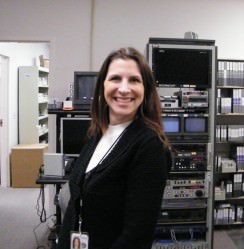
Nancy: I’m now here with Allie Lee and you are a producer for NASA TV?
Allie: I am, for Kennedy Space Center Television.
Nancy: What are some of the things you get to do. Or have to do?
Allie: I’m in charge or preparing the launch countdown show prior to launch and all the press conferences and media briefings that we do leading up to launch. But the most exciting thing that I get to do is work with the launch commentator, which a lot of times is George Diller, and work with him about what elements we’re going to put in the show, what things do we need to show on NASA TV, and I get to sit in the control room with all the fabulous employees that we have and watch the astronauts and the space shuttle get ready to launch.
Nancy: How long have you been here?
Allie: I’ve been here five years.
Nancy: Any memorable moments or times, or launches that you have been a part of?
Allie: I think the last launch was pretty special (STS-130). It happens to be the first one I got to do by myself as a producer. It was a fun launch, a beautiful launch in the evening. It was just wonderful to see the astronauts come out and get loaded up into the shuttle and wait for it and hear that countdown.
I would also say that another memorable flight would be STS-114, the return to flight. That was my first launch being here, and I happened to be pregnant with my little boy, so that was a nice launch.
Nancy: What are some of the challenges? Do you have to worry about timing and how you get everybody in and all the shots you want?
Allie: You do. There is a lot of tricks with it. As the producer you have to work very closely with the director who works closely with the field cameramen and the camera operators. You have to follow the astronauts schedule very closely and make sure that when a special milestone happens that the NASA TV commentator knows that it is happening, and that the director and the photographers all have that shot up on the TV so that everyone can see it and the commentator can talk about it.
You also have to be listening to the nets, to the loops and you get to listen all the people in the firing room discussing the launch. You have to listen for weather problems, weather issues. You have to listen for things that are going well, things that are not going well so that you can advise the NASA TV commentator so that he or she is preparing so they can give notice to the public, should they need to. So those are the things that are the challenges.
Working as a producer at Kennedy Space Center is a unique job, in that it is the only job like it in the world. So it is really special to me. It’s special to the whole team, but it is great to be part of this team.
Nancy: So, as you see the shuttle program coming to the end, does it…
Allie: It’s really sad. It’s really sad because we enjoy it so much and it is so beautiful. It’s going to be sad to see it go. I get to produce rocket launches, too, and those are wonderful. I’m excited that I get to be the producer for the last shuttle, I can tell you that.
Nancy: Thank you very much!
Dimitri Gerondidakis, Director.
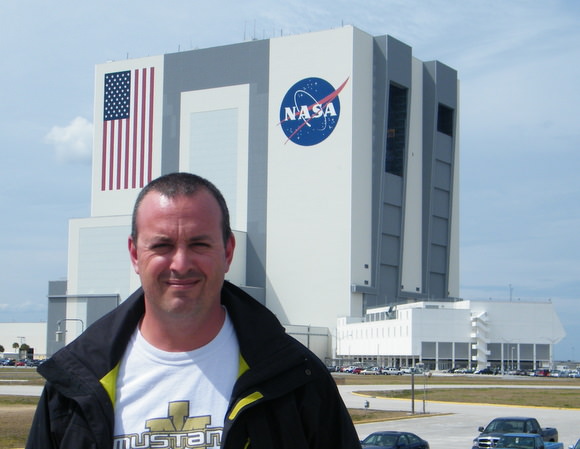
Nancy: And now I’m with Dimitri Gerondidakis. And you are one of the directors for NASA TV?
Dimitri: Yes.
Nancy: Can you me about a typical day for you, or the kinds of things you get to do?
Dimitri: Well, are you talking launch day?
Nancy: Launch day, that would be good!
Dimitri: OK, because every other day I’m just one of the troops and go out and get video and stills of different processing. But on launch day I’m lucky enough to get to direct the NASA TV launch coverage. Directing a shuttle launch is a lot different than directing news or sports or anything like that because with the shuttle launch there are actually required shots at certain times, for the paperwork for the engineers. There is a lot of timing out – at this time we need to show the engine and show the sparklers lighting the main engines. We need to stay with that shot until, what they call the mach diamonds form, coming out of the engines.
It’s not the most creative TV directing in the world, but it is no doubt exciting. The adrenaline really starts pumping.
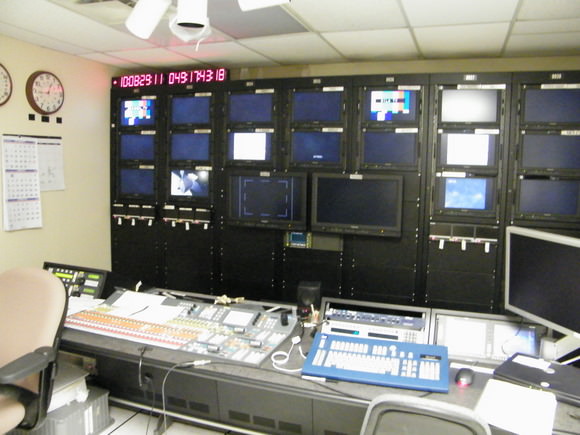
Nancy: So, you’re not only getting shots not only for us watching NASA TV, but for the engineers as well?
Dimitri: Right. I believe what I learned is that we were a news feed, so there are no dissolves; its straight cuts and stuff like that. And during the polls, we want to show the launch director polling his team. Whenever there are astronauts and we can see them, it is a required shot, like ingressing. If you watch the coverage you’ll notice that once we see astronauts we don’t get off of astronauts until they are no longer visible, like when they pull those cameras out of the crew cabin.
There’s room for some creativity, don’t get me wrong. I mostly rely on the awesome cameramen we have here that sometimes get to show their “artsy” side. They do a great job of it. Praise goes to them really. I just pick the shots I like!
Nancy: Well, I think it is always interesting to watch the launches for the variety of things you do get to see. You get to see behind the scenes – the astronauts going into the vehicle. That’s very interesting.
Dimitri: Oh yeah, that’s always a fun part of the show. There’s the part when we go into the Operations and Checkout building and we see them all suiting up and they are waving and this and that. And it’s anxious wait for us because we are waiting for them to pop out into that hallway. So while you’re trying to put on a decently entertaining good show/news feed, whatever you want to call it, you have your one eye on that hallway camera, because as soon as they come out…
Nancy: It’s one thing you don’t want to miss!
Dimitri: It’s an exciting part of the show. If the show were condensed down to 10 minutes you would probably start from there, the astronauts getting on, and coming out of the 9 minute hold.
Nancy: Right. For landing, is it kind of a waiting game like it is for the rest of us, you just have to wait and see when it is going to happen?
Dimitri: And there’s a little competition between the guys out there on the cameras who can see it first and get the shot. It’s funny, because typically they land from the north to the south, unless winds are… this is my opinion, I’m not sure if this is fact or not, but it seems to be the majority of the landings here. Well, we’re all rooting for a south to north because we have a camera on the VAB roof and you’ll see when it lands from south to north, we pullout with this big, beautiful shot with Titusville in the background, you got the rivers, the lagoons, and here’s the shuttle dropping in like a brick, almost. It just makes for a really cool shot. So there’s some friendly competition out there.
Nancy: So, coming up we have a night landing. I’m assuming that makes it a little bit harder?
Dimitri: Yeah, we don’t have our long range tracker, we have an infrared tracker which picks up a little heat signature. The first thing you see on the screen is this little white dot, and you’re going, is that it? Is that it? And finally it will start to take the shape of the shuttle and they’ll start tracking it and its pretty much infrared, which is not the prettiest picture in the world. Until I get that pilot’s point of view feed, and I’m not sure when I get it or why when I get it but you can see their point of view and the runway and the lights and then it becomes a little prettier, no doubt. Then it gets into the Xenon lights and it gets like daytime.
Nancy: Yeah, I bet! Any memorable moment that you’ve had in your time here? How long have you been with NASA?
Dimitri: I originally worked at NASA Headquarters and directed some shows there. I and a producer, my friend Tony, followed Sean O’Keefe around to different centers and did his NASA Update show. Came down here, I think it was five years ago. They were looking for someone to direct, and I asked the wife is she wanted to move to Florida and the kids loved it and so we did.
So the most memorable would have to be return to flight. The place was buzzing; it was my first. I kind of got thrown to the fire. I asked the bosses, can I watch someone else direct it first, because I have no idea what goes into it. “Nah, just get in there and do it!” So there was a lot of adrenalin and there were a lot of us new hires for return to flight, there were a lot of people here, the place was buzzing. It was probably the one I remember most.
Nancy: OK, thanks Dimitri!
Loren Mathre, Audio.
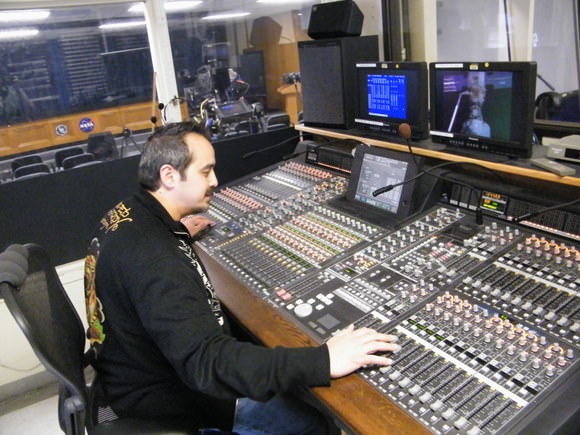
Nancy: And now I’m talking with…
Loren: Loren Mathre.
Nancy: And what do you do at NASA TV?
Loren: I work in the audio control room. We support NASA TV when it comes to any aspect of audio. For launches we put microphones out at the pad, we have one that’s maybe 100 feet from the orbiter itself and we pick up from the sparkler, so when you watch it on TV and you see the water dump and you hear that “whoooosh” and you hear the sparklers kick on, people just take it for granted that you hear that, but we have microphones out there. So we have one out there, we have one on the pad perimeter to pick it up as soon as it is launching. And then we put one on the beach, pointing straight up to get that low level rumbling you hear when the shuttle has launched.
Nancy: This was my first launch that I was here for, for Endeavour, and the thing that got me was the sound.
Loren: The sound is impressive!
Nancy: It engulfs you! So how do you – and I tried to record it and it just basically distorted everything, so what to you have to do to get good sound?
Loren: It is a fine mix. It is a different mix every launch depending on the weather, the temperature – sound travels at different levels, different speeds depending on what is in the atmosphere. The microphone we put out on the pad we’re only on that when the sparklers ignite on. Once the engines kick on you have to get off that immediately, or you have nothing but overdriven clipping noise. The pad perimeter mic, it overdrives immediately as well, but you have to ride that a little bit, so it’s a fine tuning of riding the fader and the trim pot until the microphone at the beach picks up the audio. Once the microphone at the beach picks up the audio, you’re pretty much good because the shuttle is so far away. That’s where you hear that low level crackling.
Nancy: How long have you worked here?
Loren: I’ve worked here in the TV department for 10 years. I used to be in the tech control, which is just systems, down in the industrial area. I don’t know if you’re familiar with that area – that’s where all the payloads are processed. But I was working down there for 10 years as well before I got laid off and re-called back up here. But when I was working 10 years up there I didn’t know of any of the operations up here. It’s funny how you get stuck in your own little world down there. So when I came up here it was a whole different aspect of the space program because we work hand in hand with the astronauts, you know, so you get to see them. And we handle all the press conferences, so you get to see the press conferences and you see the Administrator and Bill Gerstenmaier, all of them coming up, and you’re able to put a face and a personality to the people that are running the agency, and the astronauts themselves, so it’s a really good job.
Nancy: So, since it’s my first time here, it is my first time being at press conferences. So you’re always trying to get a shot at who is talking. How hard is that when you’ve got several people talking?
Loren: Press conferences are pretty easy, even when they are full houses. I don’t know if you were here when the NASA Administrator was here. That was a very big press conference. Normally we only have one mic handler out there, but we had two mic handlers just to handle questions from the media. It’s pretty easy, you just ride the levels. It’s nothing compared to a launch. Mixing launch audio is a tricky thing and when you get it just right you feel really good about it because not very often do you get it just right. There’s always something that afterwards you think, ‘oh, I could have gotten off that faster, I could have brought that other mic up faster.’ It’s just trial and error each time.
Nancy: And there is no do-overs.
Loren: There is no do-overs, right! A month later or so you get another shot at it. I have another audio control person out there. And we switch off launches. So when I mix a launch, he puts the mics out for me and send the signal back to me, and then when he mixes the launch, I do the same for him. So this is actually his launch, so I’m putting the microphones out for launch, and for landing – we put microphones on the runway for landings as well. Just things you take for granted that you see on TV – anything TV-wise, I always like to say, without audio KSC TV is just like a very expensive surveillance system. We add the extra to the launches and landings.
Nancy: I know! I watch NASA TV religiously and I know a lot of our listeners do to, so they will be very interested to hear about this kind of behind-the-scenes stuff.
Loren: Yeah, I went to my niece’s 5th grade class and talked about it, and you just take it for granted when you do it all the time. But I talked to my niece’s class earlier this year in January. Before me there was a police officer there and when I walked up the police officer was showing the kids his car. There was a karate instructor giving instructions on breaking boards. And here I am, I work at NASA TV, and I have a little boxful of astronaut pictures and other memorabilia, I thought, ‘This is going to be so bad.’ They loved it—the kids could not get enough about space! They had so many interesting questions for me – about a space elevator and living on the moon – these 5th graders were really interested and wanted to know more. They said I was the best – they had me signing autographs afterwards! I said, all I do is mix sound out there, but they just loved it. There is a lot of interest in the space program.
Maggie Persinger, Public Affairs/Multimedia
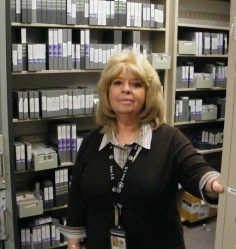
Nancy: And this is Maggie Persinger. And you get to work with all the fun technological things with video – can you tell us about that?
Maggie: Still and video. When anybody in the world from motion pictures, film, movies to newspapers, wants or needs something from KSC, or NASA, they come to me and I provide the research, the product, whatever it is that they need for their story, or for Clint Eastwood’s movie “Space Cowboys,” whatever it is. So it’s a lot. I not only deal with that, I have to make sure the jobs are shot, and that I get the copies, and I have to know the entire space program, what is going on everywhere. So it’s a difficult job for one person. There used to be three NASA people that did videos and two people did stills, so now I do it all.
Nancy: What has been the most interesting thing you’ve had to send videos or stills to?
Maggie: I think the most interesting were things like “Space Cowboys,” “Armegeddon,” “Contact,” things like that. When they used to come here and film, for a year and a half before they came and did that movie, I worked with the background people. I did things like provide them blanket pieces, tile pieces so they could build their sets. I got them the color chart for the ET tank. It was very long and involved. So whenever you deal with everybody – there’s a big Discovery program coming out about Australia. So I constantly am keeping track of these people and sending them new things. So there’s a lot of stories – there’s of interest around the world that people in Iowa don’t know realize. But I do! Because I deal with them so I know there is a lot of interest in the space program.
Nancy: I know that you are very busy even after press conferences, you are quickly handing out audio for us, it’s been great!
Maggie: That’s the thing, actually launch time is my easiest time. Even though you guys are here, I’m just dedicated to launch, all of you for this. It’s when you all leave and I have to get back to my routine when it gets tough. Because I’m dealing with the entire world, get everything shot, keeping up the library, making room – I’m constantly trying to make room for things, converting all the Quicktime files, — it’s busy. So everybody thinks it’s just busy at launch time! But launch time is my easiest time. I love launch day! It’s the rest of the time that is tough!
Nancy: Well thanks Maggie – it’s been great talking to you!
Maggie : It’s been good talking to you!
George Diller, Public Affairs Officer.
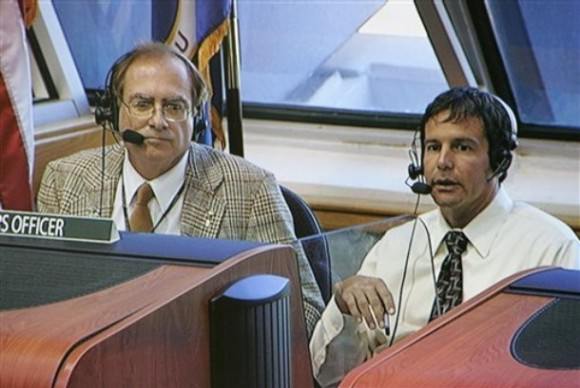
Nancy: The next voice you’ll hear you will probably recognize. He’s the voice of, I think almost all the launches here at Kennedy Space Center for the past several year. It’s George Diller. Hi George, thanks for talking with us today.
George: I do a lot of the launches but the shuttle launches we tend to spread out between among some of us in the office because there is a tremendous amount of preparation that goes into one of those so its hard for one person to do them all. I do do a lot more of the expendable launches, the unmanned launches and I really enjoy those particularly because the payloads are so different. They are deployable spacecraft that tend to be focused on space science, planetary exploration, astrophysics – those are the ones to me that have a certain amount of fascination, and always have way back from when I started here back in the late 70’s. In fact I cut my teeth as a newsman covering the space center for about five years and became particularly interested in the expendable vehicle launches with Viking, Voyager and Pioneer Venus. I’ve been here 29 years now and that still has the same attraction for me. We did launch those kinds of payloads on the shuttle for awhile and I got to work with those payloads in preparation for launch. But those all transitioned over to the expendable launch vehicles completely after the Challenger accident and the space shuttle was refocused on building the International Space Station.
If I look back probably at some of the missions that I have most enjoyed working on and doing the launch commentary for, probably the Hubble Space Telescope would the one that would be the highlight because I was directly involved with the telescope and the spacecraft payload testing and doing the commentary for launch, as well as for all the missions that have been done since that have gone up to service the telescope. So it really is quite a feeling to look back and say that I was a part of that for all of those Hubble Missions, both for the launch and all the flights that have followed to service it.
Probably the most memorable spacecraft that I have been directly involved with have been involved with particularly would be Cassini that went to Saturn and sent a probe down to Titan, one of Saturn’s moons. Also Galileo that went to Jupiter and that was such a great success and the Magellan mission to Venus. So, I think I enjoy those kinds of missions because they are leaving low Earth orbit and going so much farther out that we can only hope that one day we’ll one day go to those places ourselves.
The shuttle missions have really become focused on the space station, and it’s kind of been fun on those flights to focus on a particular piece of flight hardware that’s going up to be attached to the station, and later on when there is some kind of reference to a particular component or something particular that has been attached to it, you can remember some involvement that you’ve had with it.
But I think the space station, is, when is all finished and we look back at the science that was done over the next 10 or 15 years, I think we are going to look back at it as probably one of the wonders of the world in terms of modern accomplishments just as we have the Hubble Space Telescope, because I think so much will come out of it that is focused to us right down here on the ground. It will translate to benefits such as new metals, new pharmaceuticals, new computer substrates; new potential cures for diseases, medicines that we can get to synthesize only in the microgravity – zero gravity environment of The potential of the space station is almost mind boggling.
And I’m hoping to be around long enough to look back at the history of the space station program and say, well, I was with NASA when we were putting this together, and I may be retired eventually, but I can look back and say, look at all of the great things that now have come from the program.
Nancy: As you see the end of the space shuttle program coming, what are your personal feelings about that?
George: Well, the shuttle is something that gives us the kind of capability and flexibility that we never had before and that we do not have any plans to have again. It has the tremendous ability in terms of being able to deploy payloads, to take large payloads to space, to be able to services things in space, to be able to service things in space, to be able to construct things in space, also to be able to take things up and bring them back. And looking forward we’re going to have more capable rockets but they don’t have the same flexibility in terms of the weight that they can bring up or bring things back or be able to servicing that the shuttle has become so famous for being able to do for things already up there. So I think we’ll miss that, but it’s going to be fun to be able to look back and say the shuttle gave us the only way could have ever built the space station. I think it is a very storied program in the history of NASA. I’m proud to say I was here for the first launch and I’ll be here for the last launch and I was in some way a part of that story.
Nancy: Could you tell us about what it takes to put everything together to do a launch commentary for NASA TV?
George: The launch commentaries are, when you start planning for one, not only are there all the materials that you have to put together, but you also have to work with the TV people on all the things you want to show during the broadcast. That means scheduling all the video to be shot over a certain amount of time as the spacecraft is being prepared for launch, then all the things you want to do to tell the story, such as the animations you want to show and you have to figure out where in the broadcast its going to fit with what you are doing. Then have to schedule for it, so it’s a lot more than just writing it. Although there’s a lot of it now that, as far as the shuttle is concerned, I can work from an outline. I really don’t have to read from a script, although if I’m doing something very mission specific I might need a script for some part of it, if it is very mission specific. So, for anybody doing a launch commentary, it’s not something you can just pull together in just an afternoon. It takes a fair amount of time to pull all that together, and then work with the TV people and tell them where you want to include it and you have to work out your shot sheet of the sequence you want all these things in, so I think it’s good, in a way, that we kind of rotate the shuttle launches in particular around the office because it takes a fair amount of work to put it together. It’s a lot of fun, but it’s a lot of work!
Nancy: I’ve noticed that it seems recently you’ve had extra people come on and talk about different things going on with the mission during the launch countdown.
George: On the shuttle side, yes. On the ELV side we’ve always kind of done that. Our ELV commentary is usually divided into two parts, because the commentaries run usually between two and two and a half hours, as a rule on an unmanned launch. The first part of it picks up at a certain point in the countdown, but it is very heavy on interviews and things that are associated with the mission aspect. Usually you’re doing all that while they are fueling the vehicle. So, it gives you the chance to talk about fueling and things going on, but basically it gives you time for the color.
And then the second half of it is really focused on the launch itself and the launch operations. So it is divided into two parts that way.
On the shuttle, its more of a desire on the part of NASA to include much more activity both in terms of the mission as well as features that tell a story in the countdown and include more background that the average guy watching NASA TV can relate to. So it has meant more features, and some are related to the mission and some are related to the countdown, some are more related to the astronauts, some are more related to the people that have been involved with it, so we try to broaden it out a little bit. I think that is the reason behind that, because the count is on for such a long time. It’s one for five to five and a half hours. I think there was a feeling that we needed to do that and we had enough time to do that.
Nancy: I know I always enjoy watching as much as I can because it is fun to watch the whole process of what takes place. And now that I’ve been here and have gotten to see that, like the astronauts walking out and seeing it live and in person, its been really fun being here.
George: There have been a coupel that have almost been extravaganzas because of the nature of the mission, like the John Glenn mission. That one, there was so much you could include in the commentary because of the history of John Glenn. And he is so modest. He didn’t want us to do any more than we customarily do. But how can you not? And he is such a favorite around here. When he was here for the countdown dress rehearsal and the training, it was hard to get him through these exercises and these tests because he was just being mobbed by the NASA workers and the KSC employees. They were pulling dollar bills out of their wallets to get him to sign. And he would never be rushed. The trainers would try to keep things moving, but he would not be rushed. He took time to talk to everybody and sign their bills.
When we had the Challenger accident, he was the first person on site after the accident. He flew down here immediately and was on a briefing that afternoon over in the news center. He absolutely loves this place. He’s never forgotten it and those are the kinds of missions that have a lot of public interest. Plus the return to flight missions after Challenger and Columbia those were always big because in each case it meant a re-focusing of the program in some way. And of course the last one will just be a blowout.
Nancy: Thanks very much for talking with us today, this has been a lot of fun.
George: All right!
Nancy: I hope you enjoyed as much as I did the conversations I had with some of the people from NASA TV. NASA TV is available through many cable and satellite providers, and you can also watch it online. Go to www.nasa.gov/ntv. Reporting from Kennedy Space Center, this is Nancy Atkinson

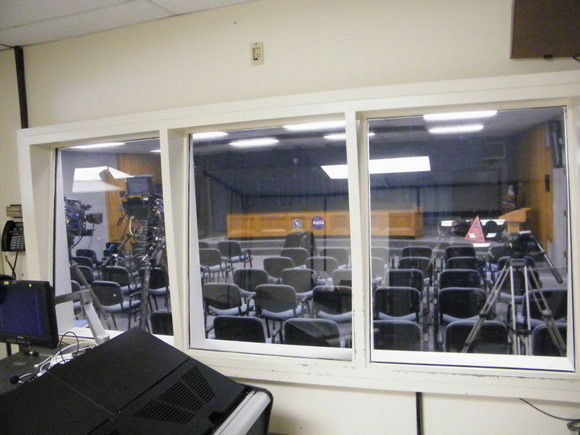
As usual, another great behind-the-scenes story, Nancy. BTW, is there a Mr. Coffee machine near the press room?
@Jon- It’s BYOC (bring your own coffee). But you can’t beat the excitement or the views!
Thanks Nancy..made me feel like I wuz right there with yah! Speaking of which, you will be there for the Space-X launch…right? Be interesting to hear your description of the sound a NINE engine rocket makes! Whoa Nelly!